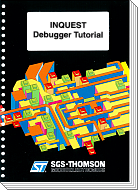INQUEST debugger tutorial
October 1995
INMOS document number: 72-TDS-465-01
92 Pages
© SGS-Thomson 1995.
Preface & Introduction

The INQUEST Development Environment is a collection of powerful software development tools designed to help you build fast, bug-free code, including a debugger and execution monitors. This document is the INQUEST Debugger Tutorial, which takes you step-by-step through the main features of the debugger, both for C users and for occam users.
Reference material on the debugger and other INQUEST tools may be found in the INQUEST User and Reference Manual.
This document contains some tutorials for one of those tools, the debugger.
Chapter 2 provides a brief introduction to the main features of the debugger. It is a fully-featured debugger that provides all the functions you need to debug sequential and parallel programs.
Chapter 3 describes, step by step, a full interactive debugging session of a simple C program.
Chapter 4 describes a post-mortem debugging session of the same program.
Chapters 5 and 6 describe similar interactive and post-mortem debugging sessions of an occam program.
To get you started quickly we have kept these tutorials brief. Inevitably this means that some features are not used.
The tutorials assume you are familiar with programming transputer systems and have some experience of using debuggers.
Contents
Preface 1 Introduction 2 Overview of the debugger 2.1 The program level 2.2 The process level 2.3 The thread level 2.4 The debugger display 2.4.1 The menu bar 2.4.2 The browser window 2.4.3 The attribute window 2.4.4 The file sub-window 2.4.5 The code window 2.4.6 The operation buttons 2.4.7 The output window 2.4.8 The command window 3 An example ANSI C interactive debugging session 3.1 The example program 3.2 Building the example program 3.3 Step-by-step tutorial 3.3.1 Starting the debugger 3.3.2 Placing a breakpoint 3.3.3 Starting the example program 3.3.4 Locating where a breakpoint has occurred 3.3.5 Removing a breakpoint 3.3.6 Examining a variable 3.3.7 Single stepping through the source code 3.3.8 Examining the call stack 3.3.9 Stepping over and out of function calls 3.3.10 Listing the current threads 3.3.11 Interrupting running threads 3.3.12 Watching communication between two threads 3.3.13 Setting a watchpoint on a variable 3.3.14 Deleting a watchpoint 3.3.15 Jumping down a channel 3.3.16 Leaving the debugger 4 An example ANSI C post-mortem debugging session 4.1 Post-mortem debugging 4.1.1 Building the code 4.1.2 Starting post-mortem debugging 4.2 Step-by-step tutorial 4.2.1 Starting and crashing the application 4.2.2 Starting the debugger 4.2.3 Using the browser 4.2.4 Examining the call stack 4.2.5 Examining a variable 4.2.6 Jumping down a channel 4.2.7 Leaving the debugger 5 An example occam interactive debugging session 5.1 The example program 5.2 Building the example program 5.3 Step-by-step tutorial 5.3.1 Starting the debugger 5.3.2 Single stepping 5.3.3 Placing a breakpoint 5.3.4 Starting the example program 5.3.5 Locating where a breakpoint has occurred 5.3.6 Removing a breakpoint 5.3.7 Examining a variable 5.3.8 Single stepping through the source code 5.3.9 Examining the call stack 5.3.10 Stepping to 5.3.11 Stepping out of function calls 5.3.12 Stepping over function calls 5.3.13 Interrupting running threads 5.3.14 Watching communication between two threads 5.3.15 Setting a watchpoint on a variable 5.3.16 Deleting a watchpoint 5.3.17 Jumping down a channel 5.3.18 Leaving the debugger 6 An example occam post-mortem debugging session 6.1 Post-mortem debugging 6.1.1 Building the code 6.1.2 Starting post-mortem debugging 6.2 Step-by-step tutorial 6.2.1 Starting the debugger 6.2.2 Examining a variable 6.2.3 Examining the call stack 6.2.4 Using the browser 6.2.5 Jumping down a channel 6.2.6 Leaving the debugger Index